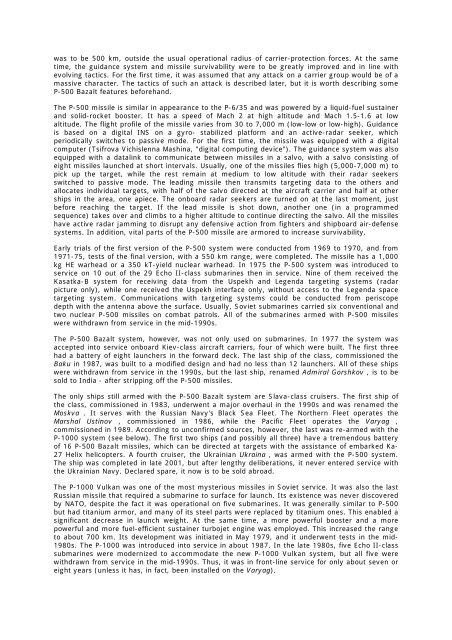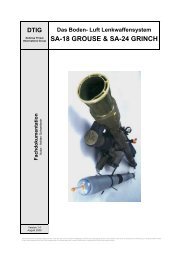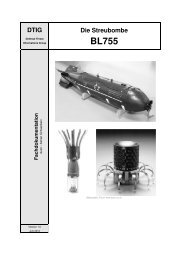RUSSIAN/SOVIET SEA-BASED ANTI-SHIP MISSILES Specia ... - DTIG
RUSSIAN/SOVIET SEA-BASED ANTI-SHIP MISSILES Specia ... - DTIG
RUSSIAN/SOVIET SEA-BASED ANTI-SHIP MISSILES Specia ... - DTIG
You also want an ePaper? Increase the reach of your titles
YUMPU automatically turns print PDFs into web optimized ePapers that Google loves.
was to be 500 km, outside the usual operational radius of carrier-protection forces. At the same<br />
time, the guidance system and missile survivability were to be greatly improved and in line with<br />
evolving tactics. For the first time, it was assumed that any attack on a carrier group would be of a<br />
massive character. The tactics of such an attack is described later, but it is worth describing some<br />
P-500 Bazalt features beforehand.<br />
The P-500 missile is similar in appearance to the P-6/35 and was powered by a liquid-fuel sustainer<br />
and solid-rocket booster. It has a speed of Mach 2 at high altitude and Mach 1.5-1.6 at low<br />
altitude. The flight profile of the missile varies from 30 to 7,000 m (low-low or low-high). Guidance<br />
is based on a digital INS on a gyro- stabilized platform and an active-radar seeker, which<br />
periodically switches to passive mode. For the first time, the missile was equipped with a digital<br />
computer (Tsifrova Vichislenna Mashina, "digital computing device"). The guidance system was also<br />
equipped with a datalink to communicate between missiles in a salvo, with a salvo consisting of<br />
eight missiles launched at short intervals. Usually, one of the missiles flies high (5,000-7,000 m) to<br />
pick up the target, while the rest remain at medium to low altitude with their radar seekers<br />
switched to passive mode. The leading missile then transmits targeting data to the others and<br />
allocates individual targets, with half of the salvo directed at the aircraft carrier and half at other<br />
ships in the area, one apiece. The onboard radar seekers are turned on at the last moment, just<br />
before reaching the target. If the lead missile is shot down, another one (in a programmed<br />
sequence) takes over and climbs to a higher altitude to continue directing the salvo. All the missiles<br />
have active radar jamming to disrupt any defensive action from fighters and shipboard air-defense<br />
systems. In addition, vital parts of the P-500 missile are armored to increase survivability.<br />
Early trials of the first version of the P-500 system were conducted from 1969 to 1970, and from<br />
1971-75, tests of the final version, with a 550 km range, were completed. The missile has a 1,000<br />
kg HE warhead or a 350 kT-yield nuclear warhead. In 1975 the P-500 system was introduced to<br />
service on 10 out of the 29 Echo II-class submarines then in service. Nine of them received the<br />
Kasatka-B system for receiving data from the Uspekh and Legenda targeting systems (radar<br />
picture only), while one received the Uspekh interface only, without access to the Legenda space<br />
targeting system. Communications with targeting systems could be conducted from periscope<br />
depth with the antenna above the surface. Usually, Soviet submarines carried six conventional and<br />
two nuclear P-500 missiles on combat patrols. All of the submarines armed with P-500 missiles<br />
were withdrawn from service in the mid-1990s.<br />
The P-500 Bazalt system, however, was not only used on submarines. In 1977 the system was<br />
accepted into service onboard Kiev-class aircraft carriers, four of which were built. The first three<br />
had a battery of eight launchers in the forward deck. The last ship of the class, commissioned the<br />
Baku in 1987, was built to a modified design and had no less than 12 launchers. All of these ships<br />
were withdrawn from service in the 1990s, but the last ship, renamed Admiral Gorshkov , is to be<br />
sold to India - after stripping off the P-500 missiles.<br />
The only ships still armed with the P-500 Bazalt system are Slava-class cruisers. The first ship of<br />
the class, commissioned in 1983, underwent a major overhaul in the 1990s and was renamed the<br />
Moskva . It serves with the Russian Navy's Black Sea Fleet. The Northern Fleet operates the<br />
Marshal Ustinov , commissioned in 1986, while the Pacific Fleet operates the Varyag ,<br />
commissioned in 1989. According to unconfirmed sources, however, the last was re-armed with the<br />
P-1000 system (see below). The first two ships (and possibly all three) have a tremendous battery<br />
of 16 P-500 Bazalt missiles, which can be directed at targets with the assistance of embarked Ka-<br />
27 Helix helicopters. A fourth cruiser, the Ukrainian Ukraina , was armed with the P-500 system.<br />
The ship was completed in late 2001, but after lengthy deliberations, it never entered service with<br />
the Ukrainian Navy. Declared spare, it now is to be sold abroad.<br />
The P-1000 Vulkan was one of the most mysterious missiles in Soviet service. It was also the last<br />
Russian missile that required a submarine to surface for launch. Its existence was never discovered<br />
by NATO, despite the fact it was operational on five submarines. It was generally similar to P-500<br />
but had titanium armor, and many of its steel parts were replaced by titanium ones. This enabled a<br />
significant decrease in launch weight. At the same time, a more powerful booster and a more<br />
powerful and more fuel-efficient sustainer turbojet engine was employed. This increased the range<br />
to about 700 km. Its development was initiated in May 1979, and it underwent tests in the mid-<br />
1980s. The P-1000 was introduced into service in about 1987. In the late 1980s, five Echo II-class<br />
submarines were modernized to accommodate the new P-1000 Vulkan system, but all five were<br />
withdrawn from service in the mid-1990s. Thus, it was in front-line service for only about seven or<br />
eight years (unless it has, in fact, been installed on the Varyag).











